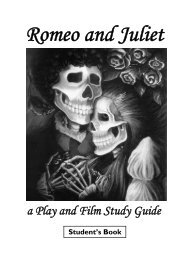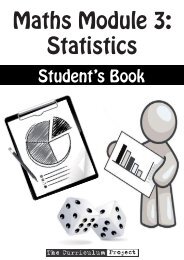Who Killed Chea Vichea?(11.3mb) - The Curriculum Project
Who Killed Chea Vichea?(11.3mb) - The Curriculum Project
Who Killed Chea Vichea?(11.3mb) - The Curriculum Project
You also want an ePaper? Increase the reach of your titles
YUMPU automatically turns print PDFs into web optimized ePapers that Google loves.
Structure of the Teacher’s Notes<strong>The</strong>se notes contain a number of tools to help students understandthe documentary and to help you guide discussions. Chapters 2-5include all of the following:IMPORTANT IDEAS – short explanations of the some of the mostimportant concepts for that section of the documentary.KEY WORDS – simple definitions of some of the more difficult wordsused in the documentary and teaching notes.COMPREHENSION QUESTIONS – activities that check students’understanding of the story and details of the documentary.SPEECH BOX QUESTIONS – activities that use direct quotes from thefilm to answer questions. Read these quotes out loud to the classand check students understand them, using the Key Words box ifnecessary.DISCUSSION QUESTIONS – activities that help the teacher to leaddiscussions about the events and issues in the documentary.EXTENSION ACTIVITIES – optional activities that support discussionabout some of the issues raised in the film.3
q&mvrf;nTefudk a&;om;xm;yHkausmif;om;rsm; ½kyf&Sifudk ydkrkdoabmaygufem;vnfap&efESihf q&mrsm;taejzifhaqG;aEG;jcif;rsm;udk aumif;pGm vrf;aMumif;ay;Ekdifap&ef taxmuftuljyK ar;cGef;tcsdKUukdþq&mvrf;nTefwGif xnfhoGif;azmfjyxm;ygonf/ tcef; 2 rS 5 txd atmufygvkyfief;pOfrsm;tm;vkH; yg0ifrnfjzpfonf/odxm;&rnfh ta&;ygaom t,ltq^t"dyÜg,frsm;½kyf&Sif ZmwfuGufrsm; pum;ajymrsm;wGif ygaom ta&;ygonfh odxm;oihfaomt"dyÜg,frsm; taumuft,lrsm;udk tusOf;&Sif;vif;csuf/tar;tajzrsm;Zmwfvrf;ZmwfuGufESihf rSwfwrf;½kyf&Sif\ tao;pdwfwkdYudk ausmif;om;rsm;rnfrSsem;vnfrSk&SdaMumif; ppfaq;&ef tar;tajz avhusihfcef;rsm;/Zmwf0ifpum; tar;tajz½kyf&SifwGif;rS ajymoGm;aom pum;twkdif;udk aumufEIwf azmfjyumar;cGef;rsm;ar;jcif;jzpfonf/aqG;aEG;zG,f ar;cGef;rsm;rSwfwrf;½kyf&SifwGifygaom jzpf&yfrsm;? udpö&yfrsm;tay: q&mu OD;aqmifaqG;aEG;&mwGiftaxmuftul jyKrnfh ar;cGef;rsm;jzpfygonf/aemufqufwGJvkyfief;pOfrsm;q&mESihf ausmif;om;rsm; qE´&SdvQif aqmif&GufEkdifonfh vkyfief;pOfrsm;jzpfygonf/þtydkif;wGif ½kyf&SifZmwfvrf;wpfavQmufwGif Munhf½IcJh&aom tcsdKU udpö&yfrsm;udkaqG;aEG;Ekdifaprnfh taxmuftyHhrsm;yg0ifygonf/4
What was the Khmer Rouge?<strong>The</strong> Khmer Rouge was a communist group that took over the capitalof Cambodia, Phnom Penh, on April 17, 1975. Under the leadership ofPol Pot, they forced almost everyone out of the cities, turning the wholecountry into a giant labour camp. <strong>The</strong>y wanted to kill anyone they thoughtwas against them. This included professionals and almost everyone withan education. During the Khmer Rouge years, between 1.7 million and3 million people (20-35% of the population) were killed or died fromstarvation or disease.3. What do you know about the Cambodian garment industry?Use the facts in the box toexplain how importantthe garment industry is toCambodia’s economy.Follow-up activity:Ask if there is a similarindustry in the students’country that is much moreimportant than any otherindustry.• <strong>The</strong>re are over 200 garment factories inCambodia, mostly in Phnom Penh.• Over 270, 000 people work in thegarment industry in Cambodia.• 65% of the country’s manufacturingworkers are in the garment industry.• <strong>The</strong> amount of wealth created by thegarment industry increased from 1.3percent in 1995 to 15.9 percent in 2006.4. What do youthink the workingconditions are like in Cambodian factories?Ask students what they expect the conditions to be like in Cambodiangarment factories. Write their ideas on the board.Follow-up activity: When this is finished, compare the facts in thefollowing box to what you have written on the board. What was thesame? What was different? Compare these to conditions in factories in thestudents’ country.7
crmeDqkdonfrSm rnfolawGenf;/crmeDrsm;rSm 1975 {NyD 17 wGif uarÇm'D;,m;EkdifiH\ NrdKUawmf zEGrf;yifudkwkdufckdufodrf;ykdufcJhaom uGefjrLepf tzGJUjzpfonf/ ygvfaygh\ acgif;aqmifrIatmufwGif crmeDrsm;u vlwkdif;eD;yg;udk NrdKUBuD;rsm;rS armif;xkwfvkdufNyD;wpfEkdifiHvHk;udk acR;wyfpcef;BuD;tjzpf ajymif;vJvkdufMuonf/crmeDrsm;u ¤if;wkdYudk qefYusifrnfxifwkdif; owfjzwf&Sif;vif;vkdMuonf/crmeDrsm;onf e,fy,ftoD;toD;rS uRrf;usifynm&Sifrsm;ESihf? ynmwwfajrmufoltm;vHk;eD;yg;udk tvGwfray;cJhay/ crmeDckESpfrsm;wGif vlaygif; 1.7oef;rS 3oef;twGif; (vlOD;a& \20 ESifh 35 &mESKef;rSm) owfjzwfcH&rI? iwfrGwfrI?a&m*gb,rsm;aMumifh aoaMucJh&onf/3/ uarÇm'D;,m; txnftvdyfvkyfief;taMumif;udk bmodxm;ygovJ/wpfzufygtcsuftvufrsm;udktoHk;jyKNyD; txnftvdyfvkyfief;onfuarÇm'D;,m;\ EkdifiHhpD;yGm;a&;twGufrnfrQ ta&;ygEkdifaMumif; &Sif;jyyg/aemufqufwGJvkyfief;pOf/ rdrdwkdhEkdifiHwGifvnf; tvm;wltjcm;vkyfief;rsm;xuf ykdta&;ygaomvkyfief;rsm;&Sdr&Sd ausmif;om;rsm;ukdar;jref;aqG;aEG;yg/4/ uarÇm'D;,m;EkdifiHrSukefxkwfpuf½kHrsm;\vkyfief;cGiftajctaersm; rnfokd h&Sd rnf[kxifygoenf;/• uarÇm'D;,m;wGif txnftvdyfpuf&Hk 200ausmf&SdNyD; trsm;pkrSm zEGrf;yifwGifjzpfonf/• vlaygif; 270 000 ausmfrQxkdvkyfief;xJwGif&SdMuonf/• EkdifiHukefxkwfvkyfom;rsm;\ 65% rSmtxnftvdyfvkyfief;rSjzpfonf/• txnftvdyfvkyfief;rS &&SdaomEkdifiH
• Cambodian law says that workers must earn at least US $65 a month,though some employers pay much less than this.• According to the Cambodian Centre for Human Rights, this wage is notenough for workers to have a good standard of living.• Some factories force their workers to work very long hours.• Some factories do not have equipment to protect their employees fromdangerous machines and also do not provide training on how to usethem.• Some factories are dirty and the air supply can be very bad.• Even though there are laws to protect the rights of workers, these lawsonly apply to long-term contracted employees. Employers often avoidthese laws by using short-term contracts.5. What are workers' rights?First ask students what a right is, then ask the question.Possible answer: A right is the ability to do or have something. Legal rightsare protected by the law. See Important Ideas for a definition of workers'rights.6. What rights do workers have?First, brainstorm all the rights that students think workers should have.Write their ideas on the board. <strong>The</strong>n ask students to guess if garmentworkers have these rights in Cambodia. Check their answers by looking atthe list of some rights that Cambodian workers have in the text box.9
• uarÇm'D;,m;EkdifiH Oya't& tvkyform;rsm;onf tenf;qHk; 65 tar&duefa':vm&&Sd&rnf[k owfrSwfxm;onf/ okdYaomf tcsdKUtvkyf&Sifrsm;u xkdYatmuf rsm;pGmavQmhay;aeMuonf/• uarÇm'D;,m;vlYtcGihfta&;A[kd\ tqkdt& tqkdyg vpmyifvQiftvkyform;rsm;twGuf aumif;rGefpGmaexkdifEkdif&ef rjzpfEkdifao;yg/• tcsdKUpuf½kHrsm;rSm tvkyform;rsm;udk em&Daygif;rsm;pGm twif;tMuyftvkyfapckdif;Muonf/• tcsdKUpuf½kHrsm;onf tvkyform;rsm;ukd tEå&m,frsm;aompufBuD;rsm;udkifwG,f&mwGif vkdtyfaom tuG,ftum ud&d,mrsm;udkay;jcif;r&Sdovkd? toHk;jyKyHkudkvnf; oifwef;ay;jcif;r&Sdyg/• tcsdKUpuf½kHrsm;rSm oefY&Sif;rIr&Sd? av0ifavxGufraumif;/• tvkyform;tcGihfta&;udk tumtuG,fay;xm;aom Oya'rsm;&Sdyif&Sdjim;? ¤if;wdkYrSmtjrJwrf;0efxrf;rsm;twGufomjzpf&m? tvkyf&Sifrsm;u 0efxrf;rsm;udk umvwkdpmcsKyfrsm;om csKyfjcif;jzihf xkdOya'rsm;udk a&SmifMuonf/5/ tvkyform;tcGihfta&;qkdonfrSm tb,fenf;/ausmif;om;wpfOD;OD;udk tcGihfta&; [lonfh pum;\zGihfqkdcsufudk t&ifar;yg/xkdYaemufrSom txufygar;cGef;udk ar;yg/Oyrm tajzrsm;rSm- tcGihfta&;qkdonfrSm wpHkw&mudk vkyfEkdifcGihf &,lcGihfudk ajymjcif;?Oya't&owfrSwfxm;aom tcGihfta&;owfrSwfcsufrsm;vnf;&Sdonf/odxm;&rnfh ta&;ygaom t,ltq^t"dyÜg,frsm;rS tvkyform; tcGihfta&;udkzGihfqkdxm;onfudk jyefnTef;Ekdifygonf/6/ tvkyform;rsm;wGif rnfonfhtcGihfta&; &ydkifcGifh rsm; &Sdoenf;/ausmif;om;rsm; pOf;pm;EkdiforQ tvkyform;rsm;wGif&Sdoifhaom tcGihfta&;rsm;udkoifykef;ay:wGif csa&;yg/ xkd haemuf uarÇm'D;,m;wGif tqkdyg tcGihfta&;rsm;udktvkyform;rsm; &&Sdjcif; &Sd?r&Sd udkar;yg/ tajzrsm;ukd oif&kd;rSwfpkwGif azmfjyxm;onfhuarÇm'D;,m;rStvkyform;rsm; &&Sdonfh tcGihfta&;rsm; ESifh wkdufíf rSefueffrI &Sdr&SdMunfhyg/10
• 15 as the minimum working age• Clean, healthy and safe working conditions• One and a half days holiday per month• No more than 48 hours of work per week• Maternity leave: women who have recently given birth can take time offwork (including 90 days with full pay)• No discrimination based on age, gender, ethnicity, religion, or politicalbeliefs• <strong>The</strong> right to join a trade union7. Is it the same in your country?Ask if these rights are the same in the students’ country. Ask which rightsare most important. Ask if all these rights are respected. Why or why not?Extension Activities: Trade UnionsDiscuss the questions as a class.1. What do trade unions do?Possible answer: Unions do many things fortheir members, including:• negotiate with management about workingconditions and pay.• provide services such as financial or legalsupport to workers.• organise strikes (days when all workers do not work) ordemonstrations to put pressure on management.2. Do workers need trade unions? Why?Possible answer: Union members say that they are important becausethe people that run companies will usually only give fair wages andgood working conditions if they are pressured by the workers. Also,unions are one of the few ways of communicating workers' needs andwishes. On the other hand, you could argue that good laws, properlyenforced, make unions unnecessary.11
• 15ESpfjynfhrSom tvkyfvkyfcGihf&Sdonf/• oefY&Sif;rI&Sdaom? usef;rma&;udk rxdckdufapaom? tEå&m,fuif;aomywf0ef;usifwGif tvkyfvkyf&rnf/• wpfvvQif ydwf&uf wpf&ufcGJcHpm;cGihf&Sdonf/• wpfywfvQif tvkyfvkyfcsdef 48 em&Drausmfap&/• rD;zGm;cGihf/ rD;zGm;NyD;p tvkyform;rsm; uav;ukdapmihfa&SmufEkdif&ef &ufaygif; 90vpmtjynfhcHpm;cGihf&Sdonf/• touft&G,ft&? usm;^r jzpfjcif;t&? vlrsdK;? bmom? EdkifiHa&;,HkMunfrIrsm;udktajccHNyD; cGJjcm;qufqHcH&jcif;r&Sdap&/• ukefoG,frI tvkyform;toif;udk toif;0ifcGihf&Sdonf/7/ oifhEkdifiHwGifvnf; xkdenf;vnf;aumi;fyifvm;/4if;wdkY EkdifiHrS tvkyform; tcGihfta&;rsm;ESihfwlrwlar;yg/ rnfonfh tcGihfta&;rsm;uta&;tBuD;qHk; jzpfygoenf;/ tvkyform;tcGifhta&;rsm;udkav;pm;vkdufemjcif; &Sd r&SdtaMumif;jycsufrsm;udk ar;yg/aemufqufwGJ vkyfief;pOf/ /ukefoG,frI toif; (tvkyform;tzGJYrsm;)1/ ukefoG,frI (tvkyform;) toif;rsm;u rnfonfwkdYudkaqmif&Gufygoenf;/twef;wGif;aqG;aEG;&efar;cGef;rsm;Oyrm tajzrsm;rSm- ukefoG,frItoif;rsm;onf vkyfief;rsm;pGm vkyfaqmifMuygonf/tcsdKUrSm• vpmrsm; ESifh vkyfief;cGif tajctaersm;udk tvkyf&Sifrsm;ESihfnSdEdIif;ay;onf• tvkyform;rsm;udk aiGaMu;taxmuftyHhrsm; ? Oya’qkdif&m taxmuftyHhrsm;yHhydk;ulnDonf• oydwfarSmufjcif; (tvkyform;rsm;tm;vkH;vkyfief;cGifr0ifjcif;)? ponfhqE´jyyJGrsm;pDpOfNyD; tvkyf&Sifrsm;tay: zdtm;ay;onf2/ tvkyform;rsm;taeESihf tqkdyg toif;tzGJYrsm; vkdtyfygovm;/tb,fhaMumifhenf;/Oyrm tajzrsm;rSm- tzGJU0ifrsm;twGuf tvkyform;toif;rsm; vkdtyfygonf/tb,fhaMumihfqkdaomf ukrÜPDrsm;rSm tvkyform;rsm;udk wwfEkdiforQ tenf;qHk;aomvpm ESihf tcGihfta&;ay;vkdjcif;aMumifh j zpfygonf/ tvkyform;tzGJYrsm;tm;jzifhtvkyform;rsm;\vkdtyfrSKrsm; oabmxm;rsm;udkwifjyay;Edkifonf/tjcm;wzufrSvn;f tvkyform;tufOya'rsm;udk av;pm;vkdufemygutvkyform;tzGJUrsm;udk zGJUpnf;&ef rvkdtyfyg/12
2. <strong>The</strong> Setting (00:00—10:49)IMPORTANT IDEAScoalition government: a government made from more thanone political party. When no party gets enough votes to be thegovernment alone, different political parties need to negotiate witheach other to make an agreement about how the power will beshared. When these parties cannot agree, this is called deadlock.Key Wordscompete (v): to try to do something better than otherschampion (n): someone who fights for or defends the rights of someoneelsecritic (n): someone who points out what is bad or wrong about somethingfaltering (adj): becoming less powerful or successfuldominate (v): to control, to be the most powerfulprominent (adj): important or well-knownministry (n): a high-level part of the governmentrefuse (v): to say no, or not agree to do something.bodyguard (n): a person, or group of people, who protect someonecommander (n): a military or police leaderroyalist (adj, n): supportive of a king or queenparliament (n): the place where politicians discuss and make new lawssatisfied (adj): feeling that something is good enoughruling party (n): the political party that is currently in governmentopposition party (n): a political party that is competing to be ingovernmentBefore you watchDiscuss the question and tell the students to think about the questionwhile they watch the film. Discuss again after watching if necessary.1. Which of the things discussed in the last section will beimportant in this documentary?Possible answers: labour rights, unions, development, poverty, etc.13
2/ Zmwfvrf;pwifcif;usif;jcif;(00;00-10;49)odxm;&rnfh ta&;ygaom t,ltq^t"dyÜg,frsm;nGefYaygif; tpkd;&tzGJU/ / EkdifiHa&;ygwDwpfygwDxufykdNyD;yl;aygif;zGJYpnf;xm;aom tpkd;&twpf&yfudk qkdvkdonf/ tpkd;&wpf&yf tjzpfowfrSwfa&G;cs,fcH&Ekdifonfh rJta&twGufudk rnfonhfygwDrS r&&Sdaomtcg?ygwDtcsdKUu yl;aygif;vkdufNyD; tpkd;&wpf&yfzGJYum rnfokdYcGJa0tkyfcsKyfrnfudkoabmwlMujcif;jzpfonf/ xdktajctaersdK;wGif ygwDrsm;oabmrwlygurJta&twGuf rjynfhrDí rnfonhfygwDrS tpkd;& rzGJYEkdifjzpfNyD; rwkd;om rqkwfomtajctae jzpfay:vmwwfonf/½kyf&SifrMunhfrD½kyf&SifrMunhfrDwGifar;cGef;rsm;udk aqG;aEG;jyD; ½kyf&SifBunfhaepOfwGifvnf; 4if;wkdYudkpOf;pm;xm;&ef ajymyg/ vkdtyfygu ½kyf&SifMunfhtNyD;wGifvnf; xyfrHaqG;aEG;yg/1/aemufqkH; aqG;aEG;cJhonfh rnfonfh taMumif;t&mrsm;u ½kyf&SifxJwGifta&;ygvmygoenf;/ajymEkdifacs&Sdonfh tajzrsm;- tvkyform;tcGihfta&;? ukefoG,frI (tvkyform;)toif;rsm;? zGHUNzdK;wkd;wufa&;? qif;&JrJGawrI pojzifh/14
<strong>The</strong> political context2. What are the three parties that were competing in theelection?Ask the students the question. Write the names of the three parties (SamRainsy Party, Funcinpec and the Cambodian People’s Party) on the boardand read out the following quotes without saying the name of the party.Ask students which names go with which quotes.<strong>The</strong> Sam Rainsy Party Funcinpec<strong>The</strong> CPP“[He] was champion ofgarment workers andthe poor, an aggressivecritic of thegovernment and adefender of humanrights.”“Also competingwas PrinceNorodomRanariddh and hisfaltering royalistparty.”“[<strong>The</strong>y] had a lock onpower dominating themedia … the police, themilitary, the electioncommission and allprominent ministries.”Hun SenAsk the questions to check students' understanding.3. <strong>Who</strong> is Hun Sen?Answer: Prime Minister Hun Sen is the leader ofthe CPP. He first became prime minister in 1985and is still in power today. He was a Khmer Rougecommander, and has a bodyguard of over 3000 men.He called himself ‘the strong man’.15Hun Sen/[efqef;
4/ [efqef;u tb,faMumifhrdrdudk,fukd vloefBuD;[k ac:ygovJ/Oyrm tajzrsm;- crmeD acgif;aqmifjzpfcJhzl;jcif;aMumifh &ufpufMurf;MuKwfaomvkyf&yfrsm;wGif yg0ifcJhEkdifaMumif; rSef;qEdkifygonf/ oufawmfapmihfrsm;pGmxm;jcif;aMumifh vlrkef;rsm;ol jzpfaMumif;? vlrsm;u olUudk aMumuf&GHUaMumif;rSef;qEkdifygonf/ tmPmudk cJGa0ray;csifbJ rdrdoabmjzihf qHk;jzwfcsufrsm;csumtkyfcsKyfoljzpfaMumif;vnf; xif&ygonf/a&G;aumufyJGausmif;om;rsm;½kyf&Siftay:em;vnfrIudk qef;ppf&ef atmufygar;cGef;rsm;udkar;yg/Zmwf0ifpum;aumufEkwfcsufrsm;ESihf qufpyfum ar;cGef; 6rS8 txd tajzrsm;udk&Sif;jyyg/5/ a&G;aumufyGJrS rnfokdY &v'f xGufvmygoenf;/tajz/ uarÇm'D;,m; jynfolYygwDu ygvDrefwGif ae&mwpf0ufausmfudk&&SdatmifjrifcJhonf/ okdYaomf ¤if;wkdYygwDwpfckwnf;ESihf tpkd;&zGJY&efrSm oHk;yHkESpfyHk (67&mEIef;) &&SdrSjzpfrnf/ xkdYaMumifh tjcm;ygwDwpfckESihf yl;aygif;&efvkdonf/ okdYaomfqrf&efZDESihf zlpifyufwkdYu yl;aygif;NyD; pDyDyDudk qefYusifaeMuonf/ [efqef;ae&muqif;ay;rSom ¤if;wkdYESpfygwDyl;aygif;NyD; nGefYaygif;tpdk;& zGJUay;Ekdifrnf[kajymonf/[efqef;u ae&mrS rz,fay;EdkifonfhtwGuf qrf&efZDwkdYuvnf; tpkd;&rzGJUbJwif;cHxm;Muonf/6/ qrf&efZDygwDESihf csDAcsD&mwkdYtMum;rnfokdY ywfoufrI &Sdygoenf;/Oyrm tajzrsm;- csDAcsD&m a&mqrf&efZDuyg tvkyform;tcGihfta&;rsm;udk umuG,folrsm;jzpfMuaomaMumihf &if;ESD;pGm vufwGJtvkyfvkyfMurnfjzpfonf/7/ csDAcsD&mu tb,fhaMumihf qE´jyyGJvkyf&efjyifaeygoenf;/Oyrm tajzrsm;- csDAcsD&m\tzGJYu qrf&efZDoma&G;aumufyGJ &v'fudk rauseyfygu qrf&efZDudkaxmuful qE´jyvkdaomaMumifh jzpfonf/csDAcsD&m/ / uRefawmfwkdYuqrf&efZD&JUygwDudkaxmufyhHulnDNyD;qrf&efZD&JUygwDuuRefawmfwkdYudkjyefaxmufyHhulnD&ygw,f/18csDAcsD&m/ / uRefawmfwkdYu tm;vHk;udk&Sif;&Sif;ajymw,f/ uRefawmfwkdYuqE´jyrSm 'grSr[kwf qE´jyyGJawGudkulnDaxmufyHhrSm/ wu,fvkdYqrf&efZDygwDu a&G;aumufyGJ&v'fawGudk auseyfrI r&Sd&ifajymwm/
8. Why were <strong>Chea</strong> <strong>Vichea</strong>’s plans for large demonstrations badnews for the government?Son ChhayPossible answer: A big(Member ofdemonstration would be bad for Parliment):the CPP because it would show “If [<strong>Vichea</strong>]that the Sam Rainsy party had wished to have amore support (especially from demonstration ofthe workers) than the CPP. <strong>The</strong> more than 10,000demonstrators might also say that people he’s able to do that straightthe vote was unfair and this would away and this is not a good thingalso not be good for the CPP. that government would like tohappen.”Death threatsDiscuss the questions.9. Why do you think <strong>Vichea</strong> receivedthreats against his life?Possible answers:• Because someone wanted to stop him fromorganising demonstrations which wouldsupport the Sam Rainsy Party.• Because he was helping workers ask for higherwages and better working conditions.• Because his leadership was a possible threat tothe CPP.10. Why do you think the police told him that he should leave thecountry?Possible answer: Because the police work for the government, and theywanted him to stop his activities, especially during the election.19
8/ csDAcsD&m\ qE´jyyGJudk tpkd;&u tb,faMumihfrESpfoufjcif;jzpfygovJ/Oyrm tajz- xkdrQBuD;rm;aom qE´jyyGJrSm[efqef;\ ygwDtwGuf raumif;yg/qrf&efZD ygwDukd vlxku (txl;ojzihftvkyform;rsm;u)pdyDyD ygwDxufykdrkdaxmufcHaMumif; xif&Sm; onf/qE´jyolrsm;u rJta&twGufrSmvnf;rSefuefrI r&SdaMumif;ajymEdkifjyD; pDyDyDygwDudkrsufESmysufapEkdifaomaMumifh jzpfonf/Ncdrf;ajcmufrIrsm;atmufygar;cGef;rsm;udk aqG;aEG;yg/qGefacs (ygvDreftrwf)// wu,fvkdY olu vlwpfaomif;qE´xGufjyMur,fa[hqkd&if csufcsif;vlwpfaomif;xGufNyD;qE´jyvdrfhr,f/ tpkd;&u'DvkdkdudpörsdK;ukdawmhenf;enf;av;rS BudKufrSmr[kwfbl;/9/ csDAcsD&mu tb,fhaMumifh toufudk Ncdrf;ajcmufaompmrsm; &&SdcJhonfxifygoenf;/Oyrmtajzrsm;-• qrf&efZDygwDudk axmufcHonfhtaeESihfjyKvkyfaomqE´jyyGJBuD;udk rjzpfapvkdolwpfOD;OD;u AcsD&mudkwm;qD;vkdaomaMumifhjzpfygonf/• tvkyform;rsm;\vpm udk wkd;`rSihfawmif;qkday;jcif;ESihftjcm; vkyfief;cGiftajctaersm;udk tvkyform;rsm;bufrSulnDnSdEIdif;ay;jcif;aMumifh jzpfonf/• csDAcsD&m\ acgif;aqmifrIrSm pDyDyDtwGuf &wufrat;p&m&efpG,fwpfckjzpfaejcif;aMumifhjzpfonf/10/ &JtzGJ hu csDAcsD&mudk tb,faMumifh EkdifiHrS xGufoGm;cGmoGm;oifhajumif;?ajymonf[kxifygoenf;/Oyrmtajzrsm;- &Jrsm;u tpkd;&bufrSjzpfMujcif;aMumifh jzpfEkdifonf/ csDAcsD&m\vkyfief;tMuHtpnfrsm;udk &yfwefYapvkdaomaMumifh? txl;ojzihf a&G;aumufyGJumvwGifcsDAcsD&m\ taESmifht,Sufr&SdvkdaomaMumihfjzpfygrnf/20
Extension Activities: DemocracyStudents discuss the following questions. Use the possible answers toguide the discussion.1. <strong>The</strong> CPP has won severalelections. Does that meanCambodia is a democracy?Possible answer: Elections are animportant part of democracy, soperhaps it shows that Cambodia ispartly democratic. However, thereare many ways that a party can winan election in unfair or illegal ways,such as threatening opponents, lying about vote counts, banning otherparties, etc.2. <strong>The</strong> ruling party in Cambodia (the CPP) has been in powerfor a long time. Is it a problem if a government is run by thesame people for a very long time? Why or why not?Possible answers: It can lead to problems, including:• when government workers make mistakes or abuse their power,nobody can stop them because no one else knows what they aredoing.• the longer a party stays in power, the more control they have overother institutions that should be independent, such as the media,elections, the police and the courts.• people get used to a particular system and stop trying to improvesociety.On the other hand, if the people in power are doing a good job, perhapsit is not a problem if they stay in power for a long time.21
aemufqufwGJ vkyfief;pOfrsm;/ 'Drkdua&pDatmufygar;cGef;rsm;udk ausmif;om;rsm;tm; aqG;aEG;Muygap/ aqG;aEG;csufudk Oyrmtajzrsm;oHk;í ulnDxdef;ausmif;ay;yg/1/ pDyDyDu a&G;aumufyGJaygif;rsm;pGmudkatmifjrifvmcJhonf/ þtcsufuuarÇm'D;,m;edkifiHonf 'Drkdua&pDESihftkyfcsKyfonf[k qkdvkdygovm;/Oyrmtajzrsm;- a&G;aumufyGJrsm;onf'Drkdua&pDpepfwGif ta&;ygaomtpdwftykdif;wpfckjzpfygonf/ okd hjzpfvSsifuarÇm'D;,m;EdkifiHukd wpfenf;tm;jzifh 'Drkdua&pDEdkifiH[k owfrSwfaumi;fowfrSwfí&Edkifygonf/ okd haomf ygwDwpfckckonf w7m;r0if? rormaomenf;vrf;rsm;ESihfvnf; tEkdif&Ekdifygonf/ Oyrm NydKifbuf ygwDukd aemufqkwfatmifNcdrf;ajcmufjcif;? rJckd;jcif; rJvdrfjcif;? tjcm;ygwDrsm;udk wm;jrpfydwfodrf;jcif;ponfwkdYjzpfEkdifygonf/2/ tmPm&ygwD pDyDyDu EkdifiHudk tkyfcsKyfaeonfrSm umv MumjrihfNyDjzpfonf/tpkd;&tzGJUudk vlrajymif;bJ tcsdefMumjrihfpGm tkyfcsKyfjcif;rSm jyóemjzpfEdkifygovm;/tb,faMumihfenf;/Oyrmtajzrsm;- 4if;udk jyóemwpfck tjzpf,lqEkdifygonf/• tpkd;&tzGJU0ifrsm;u trSm;usL;vGefjcif;? tmPmtvGJoHk;pm;jcif;ponfwkdYjyKvkyfvmEkdifonf/ xkdokdY jyKvkyfaeonfudkvnf; rnfolrQrod&ír&yfwef hEdkif/• trSDtckduif;vGwfvyfpGm aeoihfonfh tzGJUtpnf;rsm;jzpfaom rD'D,m?a&G;aumufyGJrsm;? &JtzGJUESihf w&m;a&;&m rsm;tay: tcsdefMumonfESihftrQrajymif;vJaom tpkd;&\ vTrf;rkd;rI ykdvmEkdifonf/• jynfolrsm; tpkd;&pepfwpfckwnf;ESifhom tom;usoGm;jyD; vl habmiftzGJ htpnf;wkd;wufa&;twGuf MudK;yrf;rIrsm; &yfwef hoGm;rnf/tmPmvuf0,fykdifqkdifxm;olrsm;u rSefuefajzmifhrwfpGm tkyfcskKyfrnfqkdvSsiftcsdefMumjrifhaomfvnf; jyoem&SdEkdifrnfrxifyg/22
3. <strong>The</strong> Suspects (10:49–35:02)IMPORTANT IDEASa fair trial: one in which the court respects the rights of the peoplebeing tried and follows the rules of the legal system. <strong>The</strong> judge mustbe impartial (unbiased), independent (not controlled or influenced byothers), and competent (able to do his or her job well).political asylum: when someone is allowed to live in another countrybecause they are afraid they will be harmed for political reasons intheir home country.Key Wordsaid (n): money or other resources which are given (or sometimes lent) by onecountry to anotheralibi (n): a story told by an accused person to show that they weresomewhere else at the time of the crime.suspect (n): someone who the police think might have committed a crimewitness (n): a person who sees an event, usually a crime or accidentevidence (n): information used to decide if someone is innocent or guiltyconfession (n): when someone legally admits that they are guilty of a crimeplain-clothes police (n): police officers who wear normal clothingdisown (v): to legally break the relationship between a family member andthe rest of the familyBefore you watchDiscuss the question. Students think about the question while they watch.1. Why did the police think it was it so important to arrestsomeone quickly?Possible answer: Many journalists and human rights groups were speakingabout <strong>Vichea</strong>’s death. This made the government look bad around theworld. <strong>The</strong> government gets half of its money from foreign aid, andperhaps they were afraid it would be reduced. Perhaps the governmentpressured the police into 'solving' the case quickly so there would be lessinternational attention on the issue.23
3/ pGJcsufwifcH&olrsm; (10;49-35;02)odxm;&rnfh ta&;ygaom t,ltq^t"yÜg,frsm;w&m;rQwaom Mum;emppfaq;rI/ / w&m;rQwaom Mum;emppfaq;rIqkdonfrSm w&m;½kH;u ppfaq;jcif;c H&aom vlrsm;\ vlYtcGihfta&;udk av;pm;todtrSwfjyKjcif;ESihf Oya'u csrSwfxm;aom pnf;rsOf;pnf;urf;rsm;ESihftnDvkyfaqmifjcif;udk qkdvkdonf/ xkdYtjyif w&m;olBuD; onf bufvkdufrIr&Sd?MudK;ukdifrI okd hr[kwf vTrf;rkd;cH&rIuif;jyD; rdrdwm0efukd ausyGefatmifxrf;aqmifEdkifol jzpf&rnf/EkdifiHa&; ckdvHIcGihf/ / rdrdEkdifiHwGif EdkifiHa&;tajctaet&qufvufaexkdif&ef tEå&m,f&Sdaeojzifh tjcm;wEdkifiHrS xkdoludk vma&mufaexkdif&efvufcHvkdufjcif;udk EkdifiHa&;ckdvHIcGihf&&Sdonf[kac:onf/rSwfwrf;½kyf&Sifudk rMunhfrDausmif;om;rsm;udk ½kyf&SifrMunhfrDwGifatmufygar;cGef;udk ½kyf&SifMunhf&if;pOf;pm;xm;&ef ajymyg/ vkdtyfygu½kyf&SifMunfhtNyD;wGifvnf; xyfrHar;NyD;aqG;aEG;yg/1/ tb,faMumifh &JtzGJUu wpfpHkwpfOD;udk tvsiftjrefzrf;rd&ef tvGefta&;BuD;aeygoenf;/Oyrmtajz- owif;axmufrsm;? vlYtcGihfta&;tkyfpkrsm;u AcsD&m\ aoqHk;rItaMumif;udk ajymqkdaeMuonf/ ¤if;tjzpfu tpkd;&udk urÇmhtv,fwGifrsufESmysufaponf/ tpkd;&0ifaiG\ xuf0ufcefYrSm EkdifiHwum tultnDrsm;rS&&Sdaejcif;jzpf&m tqkdyg0ifaiGrsm;avsm husoGm;rnfukd pdk;&drfaeonf/ xkd haMumifhþtrIukd tjrefazmfxkwf?zrf;qD;Edkif&ef tpkd;&rS &JtzGJ hukd zdtm;ay;aejcif;jzpfEdkifonf/odkYrSom EdkifiHwumtm&kHpdkufrSK avsmhenf;oGm;rnf/24
Born SamnangAsk the questions to check students' understanding.2. What did BornSamnang say aboutthe crime?Answer: See quote box.3. What was BornSamnang’s alibi?Answer: He wasn’t inPhnom Penh but 60 km away in the town of Neak Loeung.4. What did the witnesses say?Answer: More than twelve witnesses said that Born Samnang was in NeakLoeung at the time <strong>Vichea</strong> was killed.5. Why did Born Samnang sign the confession?Answer: Because the police tortured him and threatened to do the sameto his girlfriend.6. What does this tell you about the police?Possible answer: That they use violence and threats to get what they want.7. What would you have done if you were in Born Samnang’splace?Answers based on students’ opinions.Born Samnang:“I didn’t kill anyone.<strong>The</strong>y are top officials,they can do whateverthey want. <strong>The</strong>y canturn white to black.”Sok Sam OeunAsk the questions to check students' understanding.8. What did Sok SamOeun say about thecrime?Answer: See quote box.Sok Sam Oeun:“It’s so unjust. Youtorture me. I don’tknow anything.”25
9. What was Sok Sam Oeun’s alibi?Answer: He said he was in Phnom Penh on the day <strong>Vichea</strong> was killed,celebrating Chinese New Year with friends at a house.10. What did the witnesses say?Answer: <strong>The</strong> other guests were too afraid to support his alibi. One said thatif he could be taken to another country and get someone to help him hewould “talk a lot.”11. Why do you think that none of the witnesses were willing tosupport Sok Sam Oeun’s alibi?Answer: <strong>The</strong>y were afraid of what the police would do to them.12. What were three things they said they were afraid of?Answers: See quote box.13. Why do you thinkthat witnesses forBorn Samnangopenly supportedhis alibi whilewitnesses for SokSam Oeun wouldnot?Possible answer: Because Sok Sam Oeun’s witnesses lived in the city wherethe police could threaten them more easily.<strong>The</strong> only witness of the shootingAsk the questions to check students' understanding.14. Why did the news sellerwho saw the shooting notgive evidence?Answer: See quote box.Witnesses:“In Cambodia, if you knowthings, you can die.”“If I am lost, who will feedmy kids?"“<strong>The</strong>y will arrest me andtake me to prison.”Kek Galabru(human rightsadvocate):“If she comes totestify, it’s to tell thetruth and the truth,maybe, is not whatthe police like to hear.”27
9/ tcif;jzpfyGm;&mwGif r&SdaMumif; qGwfqrftGef;u rnfokdY oufaojyajymqdkygoenf;/tajz- qGwfqrftGef;u AcsD&m towfcH&onfh aeYwGif zEGrf;yifwGifr&SdaMumif;? tjcm;rStdrfwpftdrfwGif oli,fcsif;rsm;ESihf w½kwfESpfopful;yGJ qifETJaeaMumif;ajymygonf/10/ rsufjrifoufaorsm;u rnfokdY xGufqkdMuygoenf;/tajz- ESpfopful;yGJ twlusif;yMuolrsm;u qGwfqrftGef;bufrS ulnDxGufqkd&efr0Hh&JMuyg/ tjcm;wpfOD;u ¤if;udk tjcm;EkdifiHokdYac:oGm;NyD; apmihfa&Smufay;Ekdifutrsm;BuD;ajymjyrnf[k ajymcJhonf/11/ tb,faMumifh rnfonhf rsufjrifoufaourQ qrftGef;bufrS oufaoxGuf&efr0Hh&JMuygoenf;/tajz- &Jrsm;u xGufqkdoludk &efjyKrnfudk aMumufvefYMujcif;jzpfonf/12/ rsufjrifoufaorsm;u rnfonfwkdYudk aMumuf&HGUonf[k ajymMuygoenf; /tajz- Zmwf0ifpum;ajym tuGufudkMunhfyg/13/ tb,fhaMumifh qrfeef;oufaorsm;uyGihfyGihfvif;vif;xGufqkd&JMuNyD; qrftGef;\oufaorsm;u rxGufqdk&JMuonf[kxifygoenf;/Oyrm tajz- qrftGef;\ oufaorsm;uNrdKUjyaeolrsm;jzpfjcif;aMumifh jzpfonf/&Jrsm;u tvG,fwul a&muf&SdNcdrf;ajcmufvmEkdifaomae&m jzpfaomaMumifh jzpfonf/rsufjrifoufaorsm;/uarÇm'D;,m;rSm[kdod'DodavQmufodae&ifaowwfw,f/uRefr aysmufoGm;&ifuav;awGudk b,folauR;xm;rSmvJ/olwdkYusrudk zrf;jyD; axmifcsvdrfhr,f/wpfOD;wnf;aom ypfcwfrI rsufjrifoufaoausmif;om;rsm;\ em;vnfrIudk ppfar;&ef atmufygar;cGef;rsm;ar;yg/14/ tb,faMumihf owif;pmqdkif&SifujrifawGYcJhygvsuf oufaorxGufcJhygoenf;/tajz- Zmwf0ifpum; tuGufudkMunhfyg/uuf *gvmb&l(vlYtcGihfta&; vIyf&Sm;ol)/oluoufaocHNyD;trSefawGudk vmajym&NyDqkd&if&JawGrMum;csifwJh trSefw&m;awGjzpfcsifvnf;jzpfaerSmav/28
15. What was she afraid of?Answer: See quote box.16. What did she needto do before she felt safeenough to talk about whatshe saw?Answer: Get political asylum inanother country (Thailand).17. <strong>Who</strong> was the man that she heard say “This work is done”?Answer: He was a plain-clothes policeman.What really happened?Ask the questions to check students' understanding.18. Why was Born Samnang noticed by the police?Answer: Because he was stealing money from the company he workedfor and his mother was worried that the company would take theirhouse as payment. So she decided to legally disown him and gave all thenecessary documents to the police to do this. Lieutenant Hun Song saw thedocuments related to this, and a few days after <strong>Vichea</strong>’s death he askedSamnang’s mother for a photo of him. This was the photo used to makethe picture of <strong>Vichea</strong>’s killer.19. Why was Sok Sam Oeun noticed by the police?Answer: A thief called Din Doeun and Sok Sam Oeun had an argument.<strong>The</strong> next day Din Doeun told Lieutenant Hun Song that Sok Sam Oeun waspaying people to commit murder. This was not true, but because Hun Songheard about it just a few days before <strong>Vichea</strong>’s death, Sok Sam Oeun wasarrested.20. <strong>Who</strong> was the one person who was responsible for botharrests?Answer: Lieutenant Hun Song.Va Sothy (newsseller):“If I talk about thisand the killer is stillalive then he willknow who I am andcan kill me.”29
15/ owif;pmqkdif&Sifu bmudkaMumuf&GHUcJhygoenf;/tajz- Zmwf0ifpum; tuGufudkMunhfyg/16/ qkdif&Sifu oljrifcJh&onfudktrSeftwdkif;ajym&J&efrnfonfwkdYvkdtyfygoenf;/tajz- EkdifiHa&; ckdvHIcGihf&,lrS jzpfygrnf/AmqkdoD(owif;pmqkdif&Sif)/ uRefrodwmajymvkdufw,fqkdygawmh/vlowform;uuRefrudk odoGm;NyD;awmhvmowfrSmpkd;w,f/17/ rnfolYqDrS 'DudpöatmifjrifjyD [k ajymvkdufjcif;udk olMum;vkdufygoenf;/tajz- t&yf0wfESihf &JwpfOD;qDrS Mum;vkdufjcif;jzpfonf/jzpf&yfrSefu rnfokdYenf;/ausmif;om;rsm;\ em;vnfrIudk ppfar;&ef atmufygar;cGef;rsm;udk ar;yg/18/ bGefqrfeef;udk &Ju tb,fhaMumifh rsufpduscJhygoenf;/tajz- bGefqrfeef;u ¤if;tvkyfvkyf&m aq;qkdifrS aiGrsm;ckd;,lvsuf&SdcJhonf/ aq;qkdifuaetdrfudk tavsmftjzpfodrf;rnfudk olYrdcifu pdk;&drfonhftwGuf om;jzpfolESihf Oya't&rywfoufawmhatmif om;tjzpfrS pGefYvTwf&ef qHk;jzwfvkdufonf/ xkdYaMumifh vkdtyfaompm&Gufpmwrf;rsm;udk &Jpcef;okdY wifjyí om;tjzpfrS pGefYvTwf&ef aqmif&GufcJhonf/xkdzkdifrsm;udk 'k&JrSL; [Gefaqmif;u awGY&SdoGm;onf/ csDAcsD&m vkyfMuHcH&NyD;&uftenf;i,ftMumwGif qrfeef;\ rdcifxHrS qrfeef;\ "gwfyHkudk [Gefaqmif;uawmif;,lcJhonf/ xkd"gwfyHkudk yHkwljyefqGJNyD; vlowform;yHk[k aMunmvkdufjcif;jzpfonf/19/ qGwfqrftGef;udk &Ju tb,fhaMumifh rsufpduscJhygoenf;/tajz-'if'Gef; [laom olckd;wpfOD;ESihf qGwfqrftGef;wkdY uawmufuqjzpfcJhonf/aemufwpfaeYwGif 'k&JrSL; [Gefaqmif;udk 'if'Gef;u qGwfqrftGef;onf vlowform;iSm;NyD;vlowfrIrsm;usL;vGefaeonf[k oGm;wkdifvkdufonf/ rSefuefaomwkdifcsufr[kwfaomfvnf; csDAcsD&m owfrItwGuf w&m;cHvkdaecsdefwGifwkdifvkdufjcif;aMumifh qGwfqrftGef;u tzrf;cHvkduf&jcif;jzpfonf/20/ zrf;qD;rIESpfckvHk;twGuf rnfolYwGifwm0ef&SdygovJ/tajz- 'k&JrSL; [Gefaqmif;30
21. Why were Born Samnang and Sok Sam Oeun really arrested?Possible answer: <strong>The</strong> police needed two people to accuse of killing <strong>Chea</strong><strong>Vichea</strong> (one they can say was the shooter, one the motorbike driver). Bothhad recently come to the attention of Hun Song but neither one had beenarrested for those things. Also, they they were normal, working peoplewho didn’t have important friends.Extension Activities: <strong>The</strong> CourtsStudents discuss the following questions.Use the possible answers to guide thediscussion.1. What problems did the suspectsin the documentary face in court?Answer: <strong>The</strong> judge did not listen to thewitnesses who supported their alibi.2. Was this a fair trial? Why/whynot?Possible answer: No. <strong>The</strong> court did not listen to all the evidence andthe confession was probably made under torture; and the judge mayhave been influenced by.3. What does it tell you about the court system in Cambodia atthis time?Possible answer: That the courts were more interested in achieving thegovernment’s and police’s political goals than in finding and punishingthe people who who were really guilty.31
4/ bGefqrfeef;ESihf qGwfqrftGef; ESpfOD;vHk; tzrf;cH&aom taMumif;&if; tppftrSefrSmtb,fenf;/Oyrm tajz- csDAcsD&m ao&rIudk tjypfyHkcscH&ef w&m;cHESpfOD; (vlowfw&m;cHeSifharmfawmfqkdifu,farmif;ol) tylwjyif;vkdtyfvsuf&SdaomaMumihf ¤if;wkdYESpfOD;udkzrf;qD;cJhMujcif;jzpfonf/ w&m;cHjzpf&ol ESpfOD;pvHk;\ zkdifwGJrsm;u [Gefaqmif;qDokdY tcsdefudkufa&muf&SdoGm;jcif;aMumifhjzpfonf/ okdYaomf 4if;wkdY\ rl&if;wkdifcsufrsm;aMumifhtzrf;cH&jcif;aMumifhawmhr[kwfyg/ xkdYjyif ¤if;wkdYESpfOD;vHk;u aygufaygufa&mufa&muf&Sdaom?aemufcHaumif;aumi;f&Sdaom? txufvlBuD;rsm;ESihf odaomolrsm;vnf; [kwfyHkr&ay/aemufqufwGJvkyfief;pOfrsm;/ w&m;&kH;tzGJ hatmufygar;cGef;rsm;udk ausmif;om;rsm;tm; aqG;aEG;Muygap/ aqG;aEG;csufudk Oyrmtajzrsm;oHk;í ulnDxdef;ausmif;ay;yg/1/ þrSwfwrf;½kyf&SifrS pGyfpGJcH&olrsm;rSm w&m;cGifwGif rnfonfhjyóemrsm;&ifqkdifcJh&ygoenf;/tajz- w&m;olBuD;u ESpfOD;pvHk;\ xGufqkdcsufrsm;twGuf rsufjrifoufaorsm;\oufaocHrIrsm;udk vspfvsL½Ionf/2/ w&m;cGifrSm w&m;rQwaom Mum;emrIwpfckjzpfygovm;/Oyrm tajz- r[kwfyg/ tb,fhaMumifhqkdaomf w&m;½kH;u oufaorsm;tm;vHk;udknDwlnDrQ Mum;em todtrSwfjyKrIr&SdaomaMumifhjzpfonf/ xkdYjyif 0efcHcsufuvnf;ESdyfpuf Ncdrf;ajcmufcH&csdefwGif vufrSwfxkd;aom 0efcHcsufjzpfaeonf/3/ uarÇm'D;,m;;rS w&m;a&;pepfudk ,ck rnfokdY aumufcsufcsEkdifygoenf;/Oyrm tajz- uarÇm'D;,m;\ w&m;a&;pepfrSm tjypf&Sdoludk azmfxkwftjypfay;&efxuf tpkd;&ESihf &Jrsm;\ EkdifiHa&;tusdK;tjrwfudkydkí tm½kHpkdufazmfaqmifaeonf[k ajymEdkifygonf/32
4. <strong>The</strong> Law (35:02–46:31)IMPORTANT IDEASthe law: all the laws in a country.police intimidation: when the police use their power to make peopleso afraid that they do whatever the police tell them to do.Key Wordstestify (v): to say what you saw or heard (give evidence) in courtlieutenant (n): a kind of higher-level police officerbaton (n): a heavy stick used to beat peopleprevent (v): to stop something from happeningenforce (v): to make sure that something happensexamine (v): to look at something very carefullyrelease (v): to set freethreaten (v): to warn someone that they will be hurt if they don’t do whatyou saydisappear (v): to go away without explanationinvestigation (n): looking at all the evidence to work out the truth about asituationinstitution (n): an organisation or other structure that is an important part ofthe country, such as the media or the policepolice investigation (n): the work done to find out who committed a crimeincompetent (adj): not having the ability to do something wellconsider (v): to think about somethingBefore you watchDiscuss the question and tell the students to think about the questionwhile they watch the film. Discuss again after watching if necessary.Why do we need police?Possible answer: To prevent conflict, enforce laws, and keep people safe.33
4/ Oya' (35;02-46;31)odxm;&rnfh ta&;ygaom t,ltq^t"dyÜg,frsm;Oya'/ / EdkifiHwpfEkdifiH\ Oya'? pnf;rsOf;rsm; tm;vHk;udk qkdvkdonf/&Ju Ncdrf;ajcmuftMuyfukdifjcif;/ / &Ju ¤if;wkdY\ tmPmvkyfykdifcGihfudktoHk;jyKNcdrf;ajcmufNyD; wpfpHkwpfOD;udk ¤if;wkdYjyKvkyfapvkdonfhtwkdif; vkyfaqmifapjcif;udk ac:ygonf/rSwfwrf;½kyf&Sifudk rMunhfrDausmif;om;rsm;udk ½kyf&SifrMunhfrDwGif atmufygar;cGef;udk ½kyf&SifMunhf&if; pOf;pm;xm;&efajymyg/ vkdtyfygu ½kyf&SifMunfhtNyD;wGifvnf; xyfrHar;NyD;aqG;aEG;yg/&JwyfzGJYvkdtyfygovm;/Oyrm tajzrsm;- y#dyu©rsm;udk umuG,f&ef? Oya'pdk;rkd;a&;aqmif&Guf&ef? vltrsm;udkapmihfa&Smuf&ef/34
<strong>Who</strong> has the guns?Read out the following quote and discuss the question.1. What do you think the speaker means in the quote?Possible answer: Heis saying that ordinarypeople do not have theability to kill people easilyand that if someoneis killed for politicalreasons, it is likely thatthe police or military areresponsible.How did the police hide the truth?Read out the quote box and discuss the following questions.2. Why did the police visit this woman’s house?Possible answer: Tothreaten her into keepingquiet about what shesaw.3. What does this tellyou about thesepolice officers?Possible answer: Thatthey use their power toprevent the truth fromcoming out.Ngun Soa (former DeputyChief, Phnom Penh Police):“In Cambodia, when you wantto kill someone, you look forpeople who have guns. You andI don’t have the guns. So whohas the guns in Cambodia?<strong>The</strong> police, the military people, etc.”Nguyen Thi Ngoeun(mother of Samnang’sgirlfriend):“Four or five policemen arrivedat my house. One of them wasa high-ranking official. He said,'if you do not do what I tellyou, then I will make problemsfor your family and Born Samnang won’t bereleased'… He only threatened me because Iknow this stuff is true.”35
,folUrSm aoewf&SdovJ/atmufyg Zmwf0ifpum;rsm;udk zwfjyNyD; ar;cGef;rsm;udkaqG;aEG;yg/1/ wpfzufyg pum;u bmudkqkdvkdonf[kxifygoenf;/Oyrm tajzxkdolqkdvkdonfrSmomrefvlrsm;u tvG,fwulvrlowfEkdifaMumif;? EkdifiHa&;&nf&G,fcsuft& towfcH&onfqkdygu &J (odk hr[kwf)ppfwyfaMumihfjzpfEdkifacs&Sdonf[kqkdvkdjcif;jzpfygonf/jzpf&yfrSefudk &Ju rnfokdYzkH;uG,fcJhygoenf;/atmufyg Zmwf0ifpum;rsm;udk zwfjyNyD; ar;jref;aqG;aEG;yg/2/ xkdtrsdK;orD;\ tdrfudk&Jrsm;tb,faMumihfoGm;cJhygoenf;/Oyrm tajzodxm;?jrifxm;onfrsm;udkxkwfrajymatmifNcdrf;ajcmufajymqkd&efoGm;cJhjcif;jzpfonf/EktGef;qkdtm ('k&JrSL;a[mif;?zEGrf;yif &JwyfzGJU)/ uarÇm'D;,m;rSmvlowfr,hfolu aoewf&SdwJholqDrSmtultnDawmif;&rSm cifAsm;a&muRefawmhfrSma&m aoewfr&Sdbl;aemf/'gqkd 'DEkdifiHrSm b,folaoewfudkifEkdifvJ/ &J? ppfwyftp&Sdojzihfayhg/ik,if oD ikdtGef; (qrfeef;cspfol\rdcif)/ uRefrtdrfudk &Jav;ig;a,mufavmufa&mufvmw,f/ wpfa,muf u&mxl;BuD;BuD;xJuyJ/ olckdif;wJhtwkdif;rvkyf&ifwJh uRefrrdom;pkuuRefraMumifh 'ku©a&muf&vdrfhr,fwJh/..qrfeef;vJvGwfrSmr[kwfawmhbl;wJh/ ... oluvmNcdrf;ajcmufrSmaygh/ 'Du trSefudk odaewmudk;/3/ xkdvkyf&yfu&Jt&m&Sdrsm;taMumif;rnfonfudk azmfjyoenf;/Oyrm tajz- trSefw&m;udk zHk;uG,f&ef vkyfykdifcGihfudk toHk;csMuaMumif;/36
4. <strong>Who</strong> was the police officer that came to the woman’s house?Use the quote box to help the students answer the question.Vien Thi Hong (Samnang’s girlfriend):“This is the guy who told me. He said if I say this,my family will be okay. If I don’t, my family willdisappear.”Lieutenant Hun Song:<strong>The</strong> man who arrested bothBorn Samnang and SokSam Oeun.5. <strong>Who</strong> does he work for?Answer: Deputy Police Chief Heng Pov, who hadled the <strong>Vichea</strong> investigation from the beginning.6. <strong>Who</strong> is the most powerful police officerin Cambodia?Answer: Four-star general Hok Lundy.7. <strong>Who</strong> does he work for?Answer: Only the prime minister, Hun Sen.HengPovHokLundy<strong>The</strong> judiciaryRead out the quote boxes and discuss the questions with the class. Use thepossible answers to guide the discussion.Henrik Alffram (former UN consultant):“[<strong>The</strong> judiciary] is the institution that people havethe least trust in and it’s considered to be themost corrupt...it is characterised by a high level ofincompetence, very poorly trained and educated judges.Many have not even finished high school, have no legaltraining.”37
4/ xkdtrsdK;orD;\ tdrfudk oGm;cJhonf &Jt&m&SdrSm rnfolenf;/ausmif;om;rsm;udk Zmwf0ifpum;rsm;ukd oHk;NyD; ajzqdkapyg/AD,ifoDa[mif; (qrfeef;\ cspfol)/ uRefrudk vmajymoGm;wmolyJ/ olajymckdif;wmudk ajymrS uRefr rdom;pktqifajyvdrfhr,fwJh/ r[kwf&iff uRefr rdom;pk tpaysmufoGm;vdrfhr,fwJh/'k&JrSL; [Gefaqmif;/ bGefqrfeef;ESihfqGwfqrftGef;wkdYudk wm0ef,lzrf;qD;ol/5/ 'k&JrSL;[Gefaqmif;u rnfolYtwGuftvkyfvkyfjcif;jzpfoenf;/tajz- AcsD&m aoqHk;rIudk tprS wm0ef,lpHkprf;ol'k&JcsKyf[efaygh/6/uarÇm'D;,m;wGif MoZmtmPmt&SdqHk; &Jt&m&SdrSmrnfolenf;/tajz- Mu,fav;yGihf AdkvfcsKyf [Gwfvef'D/7/ ¤if;u rnfolYtwGuf tvkyfvkyfygoenf;/tajz- 0efBuD;csKyf [efqef;twGufomjzpfonf/[efaygh[Gwfvef'Dw&m;pD&ifa&;Zmwf0ifpum;rsm;udk zwfjyNyD; ar;cGef;rsm;udk twef;vkdufaqG;aEG;yg/ jzpfEdkifaomtajzrsm;oHk;NyD; aqG;aEG;csufrsm;udk vrf;nGSefay;yg/[ef;e&pf t,fz&ef (ukv or*¾rS tMuHay;a[mif;)/tpkd;& tzGJYtpnf; tm;vHk;xJrSm &JtzGJYudk vlawG t,HktMunftrJhqHk;jzpfygw,f/ tusihfysufrI rsm;qHk;jzpfwJhae&mvkdYvJ ,lq&ygw,f/w&m;a&;eJYywfouf&ifvnf; t&nftcsif;r&SdwJhtjyifuRrf;usifvdr®mrI avhvmrI vHk;0r&SdwJh w&m;olBuD;awGyJ &Sdygw,f/wcsdKUqkd&if txufwef;awmif ratmifbl;/ Oya'udkvnf;avhvmzl;wm r[kwfygbl;/38
8. What are the causes and effects of the corrupt legal system inthe film?Possible answers – causes:• Weak and badly educated lawyers and judges.• Courts and judges are completely controlled by the government.• <strong>The</strong> former dictatorship (Khmer Rouge) has destroyed education, civilsociety and the law. Quote: “in 1982, only ten legally educated peoplesurvived in Cambodia.”Possible answers – effects:• No one trusts or respects the law.• Intimidation and bullying of the people by the police and courts.• Working for a long time in the same job means that government andlegal workers have made strong relationships with each other and usethese to create and hide corruption.• No powerful people want to change the system because it would meanthat they will be punished for what they have done in the past.9. Are these causes and effects the same in your country? Howare they different?Students answers based on their own knowledge and experience.Corruption in the courtsAsk the questions and discuss the answers.10. <strong>Who</strong> has the most power to control the courts?Answer: Om Yentieng, the prime minister’s adviserand also the head of the Cambodian Human RightsCommittee.11. What happens to judges who make theirown decisions?Answer: <strong>The</strong>y could be killed.OmYentieng39
8/ þrSwfwrf;½kyf&SifwGifygaom w&m;a&; pepftwGif;rS taMumif;t&if;cHrsm;tusdK;oufa&mufrIrsm;rSm tb,fenf;/Oyrm tajzrsm;- taMumif;t&if;rsm;/• ynmrwwfaom nHhzsif;onfh a&SUaersm;ESihf w&m;olBuD;rsm;/• w&m;½kHk;rsm;ESihf w&m;olBuD;rsm;udk tpkd;&uom tjynfht0 xdef;csKyfxm;jcif;/• crmeDrsm;vufxufwGif crmeDrsm;u ynma&;? vlrItzGJUtpnf;ESihf Oya'rsm;udk½kdufcsdK;zsufqD;cJhjcif;/½kyf&SifrS ajympum;wpfckrSm ]tJh'Dtcsdefwkef;u 1982 0ef;usifavmufuaygh/uarÇm'D;,m;rSm Oya'uRrf;usifol 10 a,mufyJ touf&Sif usef&pfw,f}/Oyrm tajzrsm;- tusdK;oufa&mufrIrsm;/• Oya'ukdrnfolrQ ,HkMunfpdwfcsjcif; av;pm;jcif;r&Sd• &JESihf w&m;½kH;u vltrsm;udk Ncdrf;ajcmuf tEkdifusihfjcif;• wpfae&mwnf;wGif tpkd;&ESihf w&m;a&;wkdYtcsdefMumjrihfpGm wGJvkyfjcif;aMumifhywfoufrIykdBuD;rm;vmNyD; ywfouf&m ywfoufaMumif;rsm;udk toHk;jyKumtusihfysufrIrsm; usL;vGefjcif;? zHk;uG,fay;Mujcif;• tmPm&Sdaeolrsm;uvnf; pepfudk ajymif;vJ&ef rBudK;pm;Mu/ pepfajymif;yguvnf;¤if;wkdY vkyfcJhonfh tjypfrsm;udk jyefay;qyf&efom&Sdonf/9/ xkd taMumif;t&mrsm; tusdK;oufa&mufrIrsm;udk ausmif;om;rsm;\EkdifiHwGifvnf;awGYEkdifygovm;/ rnfokdY rwluGJjym;Muygoenf;/ausmif;om;rsm;u odxm;MuHKxm;onfrsm;t& ajzMum;&ef/w&m;½kH;rsm;\ tusihfysuf jcpm;jcif;ausmif;om;rsm;udk atmufygar;cGef;rsm;ar;NyD; tajzrsm;udk aqG;aEG;apyg/10/ rnfolu w&m;½kHk;rsm;udk tvTrf;rdk;qHk;jzpfoenf;/tajz- 0efBudrf;csKyf\ tMuHay; ESihf uarÇm'D;,m;vlYtcGihfta&; aumfrDwDOuúX OKrf&rfwkdif;?11/ rdrdukd,fydkif qHk;jzwfcsufcsrdaom w&m;olBuD;rsm;rnfokdYjzpfoGm;Ekdifygoenf;/tajz- towfcH&onftxd jzpfEkdifygonf/OKrf&rfwkdif;40
5. Why was <strong>Chea</strong> <strong>Vichea</strong>killed? (46:31–55:27)IMPORTANT IDEASinvestment: buying part of a company in exchange for a part of theprofits that the company makesunskilled labour: work that can be done without training or educationcivil society: non-government organisations that provide services totheir communityKey Wordsclear cut (adj): easy to understandstubborn (adj): not wanting to change your opinions or decisionsexports (n): the things that a country sells to other countriesimport (n): the things that a country buys from other countriesfire (v): to tell a worker that they have to leave their jobviolate (v): to abuse or damage something that belongs to someone else<strong>The</strong> Free Trade Union Of Workers Of <strong>The</strong> Kingdom Of Cambodia(FTUWKC) (n): the trade union that <strong>Chea</strong> <strong>Vichea</strong> was president of.Before you watchAsk students if they have any questions or if there is anything they don’tunderstand.Guiding question: <strong>Who</strong> really killed <strong>Chea</strong> <strong>Vichea</strong>?WEB LINKTo read recent news about the the story and the film go to:• http://blog.whokilledcheavichea.com/• http://www.facebook.com/whokilledcheavichea43
5/ csDAcsD&m tb,fhaMumihfvkyfMuHcHcJJh&ygovJ/ (46;31-55;27)odxm;&rnfh ta&;ygaom t,ltq^t"dyÜg,frsm;&if;ESD;`rSKyfESHrI/ ukrÜPDwpfckrS &&Sdonfh tusdK;tjrwfwpfpdwfwpfykdif;udk&,lcHpm;&ef xkdukrÜPD\ wpfpdwfwpfa'o udk 0,f,ljcif;/uRrf;usifrIrJhvkyftm;/ (um,vkyftm;ponfh) ynm&yf? uRrf;usifrIponfwkdYr&SdbJ vkyfukdifEkdifaom tvkyfrsm;/vlrI tzGJYtpnf;/ vlxk&yf&GmtwGuf ta&;ygaom tultnDrsm;0efaqmifrIrsm;ay;aom (tpkd;&r[kwfonfh) tzGJYtpnf;rsm;udk ac:jcif; jzpfonf/rSwfwrf;½kyf&SifrMunfhrDausmif;om;rsm;udk odvkdonfrsm; r&Sif;vif;onfrsm;ar;cGihfay;yg/OD;wnfar;cGef; / csDAcsD&m udk trSefwu,f vkyfMuHowfjzwfol rnfolenf;/tifwmeuf pmrsufESm vdyfpmowif;rsm;ESihf þrSwfwrf;½kyf&SiftaMumif;udk xyfrHzwf½I&ef atmufygvdyfpmwdkYudkoGm;a&mufzwf½IEkdifonf/• http://blog.whokilledcheavichea.com/• http://www.facebook.com/whokilledcheavichea44
Was he killed as a threat?Read out the following text and discuss the questions.In the years after <strong>Chea</strong> <strong>Vichea</strong> was killed, two other trade unionleaders were also killed in almost the same way. In May 2004 RosSovannarith, the FTUWKC President at the Trinunggal Komarafactory, was murdered by two men on a motorbike. Hy Vuthy, theFTUWKC president at the Suntex garment factory was shot dead bytwo men on a motorbike on February 24, 2007. Vuthy had receivedtelephone death threats three months before.1. What are the similarities between the killing of these men andthe death of <strong>Chea</strong> <strong>Vichea</strong>?Answer: All three were FTUWKC union leaders, all three were killed by twomen on motorbikes, and both Vuthy and <strong>Vichea</strong> received death threatsbefore their murders.2. What do you think is the effect of these killings on workers inthese, and other, factories in Cambodia?Possible answer: It makes other workers too afraid to try and change theworking conditions in their factories.3. <strong>Who</strong> would benefit from these killings?Possible answer: <strong>The</strong> government and business owners.45
AcsD&monf &efpG,fwpfck taeESihf &Sif;vif;cH&jcif; jzpfygovm;/atmufyg pmom;udk zwfjyNyD; ar;cGef;udk ar;jref;aqG;aEG;yg/csDAcsD&m vkyfMuHcH&aomESpftwGif;wGif tjcm; tvkyform;acgif;aqmifESpfOD;vnf;xkdyHkpHtwkdif; vkyfMuHcHcJh&onf/ 2004 arv wGif x&Deef*,f udkrm&m puf½kHrS a&mhpfqkdAefem&pfof [kac:aom tvkyform;acgif;aqmifudk qkdifu,fwpfpD;ESihfvlESpfa,mufu owfjzwfoGm;onf/ 2007ckESpf azaz:0g&Dv 24&ufaeYwGif[ef;wufpf txnftvdyfpuf½kHrS [kdifAwfoD [lonfh tvkyform; acgif;aqmifudkvnf; qkdifu,fESihf vlESpfOD;rS ypfowfoGm;Muonf/ [kdifAwfoDraocifokH;vcefYu w,fvdzkef;rSowfypfrnf[laom jcdrf;ajcmufpmudk vufcH&&SdcJhonf/1/ tqkdygvlrsm;udk owfjzwfjcif;ESihf csDAcsD&m towfcH&jcif;wkdYwGif rnfonfwkdYwlnDMuygoenf;/tajz- tm;vHk;rSm tvkyform; acgif;aqmifrsm;jzpfonf/ tm;vHk;udk qkdifu,fay:rSvlESpfOD;u ypfowfoGm;Muonfjcif;wlonf/ AwfoDESihf AcsD&mwkdY raocifNcdrf;ajcmufpmrsm;&&SdMuonf/2/ tqkdyg tvkyform;acgif;aqmifrsm; towfcH&jcif;onf uarÇm'D;,m;\tjcm;puf½kHrsm;rS tvkyform;rsm;tay: rnfonhf tusdK;oufa&mufrIwkdY&Sdrnfenf;/tajz- tjcm;puf½kHrsm;rS tvkyform;rsm;taeESihf vkyfief;cGiftajctaersm;ajymif;vJ&efawmif;qkdjcif;rsm; ponfwkdYjyKvkyf&ef aMumuf&HGUoGm;apygonf/3/ xkdowfjzwfrIrsm;aMumifh rnfolwkdY tusdK;tjrwf&&Sdrnfenf;/Oyrm tajz- tpkd;&ESihf pD;yGm;a&; vkyfief;&Sifrsm;/46
Was he killed for political reasons?Read out the quote boxes before discussing the questions.Sam Rainsy:“Maybe they wantto send a messageto another leader…Sometimes theydon’t dare to kill themain target. <strong>The</strong>y killsecondary target.”4. <strong>Who</strong> do you think was the “maintarget” that Sam Rainsy talksabout? Why do you think theywould be targeted?Son Chhay (Member ofParliament):“So thismessage isclear cut.Stop beingstubborn.Accept HunSen, take what we give youand produce a newgovernment."Possible answer: <strong>The</strong> Sam Rainsy Party and Funcinpec politicians.5. How did the political deadlock come to an end?Possible answer: Prince Ranariddh stopped working with Sam Rainsy andjoined Hun Sen in a new two-party coalition government. On July 15, 2004,Hun Sen was made prime minister again.6. <strong>Who</strong> benefited politically from the death of <strong>Chea</strong> <strong>Vichea</strong>?Answer: Hun Sen and CPP.47
AcsD&monf EkdifiHa&; &nf&G,fcsufrsm;aMumifh towfcH&jcif;jzpfygovm;/atmufyg Zmwf0ifpum;rsm;udk zwfjyyg/ NyD;aemuf ar;cGef;rsm;udk aqG;aEG;yg/qrf&efZD/ olwkdYawGuwjcm;acgif;aqmifwpfa,mufa,mufudkowday;csifwmjzpfEkdifw,f/wpfcgwav olwkdYuwu,hf ypfrSwftppfudkrowf&JMubl;av/ 'Dawmh 'kwd, ypfrSwfudkowfMuwmyg/qGefacs (ygvDreftrwf)/'Dawmh owday;csufu&Sif;ygw,f/ cgif;rrmeJY/[efqef;ukd vufcHyg/ay;wmudk,lvkdufNyD;awmhtpkd;&tzGJYav;ay:vmatmif ulnDvdkufqkdwmyJjzpfygw,f/4/ qrf&efZDajymaom t"du ypfrSwfqkdonfrSm rnfolwkdYjzpfygoenf;/ tb,fhaMumifh¤if;wkdYudk t"du ypfrSwftjzpf owfrSwfMuygoenf;/Oyrm tajz- [efqef;\ ygwDESihf ryl;aygif;bJwif;cHaeaom qrf&efZDygwDESihf zlpifyufygwDrS EkdifiHa&;orm;rsm;/5/ EkdifiHa&; wkd;r& qkwfr&tajctae udk rnfokdY tqHk;owfoGm;ygoenf;/Oyrm tajz- rif;om; &mem&vfu qrf&efZDygwDESihf vufwGJjzKwfNyD; [efqef;\ygwDESihf ESpfygwD nGefUaygif; tpkd;&zGJU&ef yl;aygif;vkdufonf/ 2004 ckESpf Zlvkdif 15 wGif[efqef;udk 0efBuD;csKyftjzpfxyfrHwifa`rSmufvkdufMuonf/6/ csDAcsD&m aoqHk;jcif;wGif rnfolwkdY EkdifiHa&;t& tjrwf&&SdcJhoenf;/tajz- [efqef;ESihf pDyDyD/48
Was he killed because of money?Read out the following facts to the class and discuss the questions. Use thepossible answers to guide the discussion.• During the 1990s Cambodia opened up its economy to foreigninvestment.• Many foreign investors wanted to do business in Cambodia because of allof the cheap, unskilled labour.• Exports grew from nothing in 1994 to $1.9 billion in 2004.• Two-thirds of garment sales are to the United States, and most of therest to the European Union.• <strong>The</strong> US spent 9% of its garment import money on business withCambodia in 2002, 12% in 2003 and 14% in 2004.• Because the government and businesses wanted to continue to attractforeign investors, they wanted to make sure that the labour stayed cheapby making sure that costs (wages, safety equipment, holiday pay, etc.)stayed low in the factories.7. What do you think the government and business owners did tomake sure that costs stayed low?Possible answers: <strong>The</strong>y threatened unionists and other workers, cheatedthem with short contracts, lied about the conditions in the factory, etc.8. What problems do you think workers would face if they triedto tell people about the conditions in garment factories?Possible answer: Cambodian workers don’t want talk about on theirconditions of work because they are afraid that they will be fired. Manyof the workers have no opportunity for other employment because noother garment factory will want a worker who says bad things about theconditions.49
csDAcsD&mudk aiGaMu;aMumifh owfjcif;jzpfygovm;/atmufygtcsuftvufrsm;udk zwfjyNyD; ar;cGef;udk aqG;aEG;yg/ jzpfEdkifonfhtajzrsm;udktokH;jyKjyD; aqG;aEG;csufrsm;udk ulnDyHhydk;ay;yg/• 1990 ckESpfrsm;twGif;wGif uarÇm'D;,m;u EkdifiHhpD;yGm;a&;wGif EkdifiHjcm;&if;ESD;`rSKyfESHrIudk vufcHcJhonf/• EdkifiHjcm;&if;ESD;`rSKyfESHolrsm;u uarÇm'D;,m;wGif vkyfief;rsm;vkyfudkifvkdMuonf/aps;aygaom um,vkyftm;rsm;pGmudk &EkdifaomaMumifh jzpfonf/• 1994 wGif wifydkYrIwefzkd; vHk;0r&Sd&mrS 2004 wGif wifydkYrIrS 0ifaiGa':vmoef;aygif; 1900 txd jrihfwufvmcJhonf/• txnftvdyfvkyfief;rS wifydkYrI oHk;yHkESpfyHkrSm tar&duefjynfaxmifpkokdYjzpfNyD;usefonfh tm;vHk;eD;yg;rSm Oa&my EkdifiHrsm;okdYwifykdYjcif;jzpfonf/• 2002 wGif tar&duefjynfaxmifpkudk txnftvdyfwifoGif;rItm;vHk;\ 9%rSmuarÇm'D;,m;rS jzpfonf/ 2003 wGif 12% jzpfvmNyD; 2004 wGif 14%txdwkd;wufvmcJhonf/• tpkd;&ESihf pD;yGm;a&;vkyfief;&Sifrsm;u EkdifiHjcm;&if;ESD;`rSKyfESHolrsm;udkqufvufqGJaqmifEdkif&ef ukefusp&dwf aps;enf;oufomatmifvkyfxm;Muonf/xkdokdYaps;enf;oufomap&ef tvkyform;vpm? tEå&m,fumuG,fonhfypönf;ud&d,mrsm;? ydwf&ufvpmrsm; ponfwkdYwGif acRwmxm;jcif;jzpfonf/7/ tpkd;&ESihf pD;yGm;a&;orm;rsm;u ukefusp&dwfrsm;oufomatmif rnfokdYjyKvkyfxm;ygoenf;/Oyrm tajzrsm;- tvkyform;toif;0ifrsm; tjcm;tvkyform;rsm;udk Ncdrf;ajcmufjcif;?umvwkd pmcsKyfrsm;omcsKyfNyD; owfrSwfcsufrsm;udk a&Smif&Sm;jcif;? puf½kHrS vkyfief;cGiftajctaersm;udkvdrfnmjcif;? ponfwkdYjzpfonf/8/ txnftvdyf ukrÜPDrsm;rS tvkyform;rsm;u vkyfief;cGiftajctaersm;udkvltrsm;od&ef xkwfazmfajymygu rnfonfhjyóemrsm; jzpfay:vmrnfxifygoenf;/Oyrm tajz- uarÇm'D;,m; tvkyform;rsm;u olwkdY\ tvkyfvkyf&onfhtajctaersm;udk rsm;aomtm;jzihf rajymvkdMuyg/ tvkyfjzKwfcH&rnfudk aMumufMuonf/tvkyfxkwfcH&vQif tjcm;ae&mrsm;wGifvnf; tvkyf&&Sd&efrvG,fyg/ tvkyfvkyf&onfhtajctaetaMumif; raumif;onfrsm;udk xkwfazmfajymwwfonf[k emrnfxGufoGm;vQifrnfolrQcefYcsifrnfr[kwfaomaMumifhjzpfonf/50
<strong>The</strong> world’s responseRead out the quote boxand ask the questions.9. <strong>The</strong> United Statesand EuropeanUnion are thebiggest tradepartners withthe Cambodiangarment industry. How do you think this might have affectedthe statements made by the US and British ambassadorsmentioned in the documentary?Sam Rainsy:<strong>The</strong> internationalcommunity hasother, biggerconcerns.<strong>Chea</strong> Mony (<strong>Chea</strong><strong>Vichea</strong>’s Brother):“This is a government that’scorrupt, that murderspeople, violates humanrights, and the U.S. embassysays that human rights haveimproved.Possible answer: <strong>The</strong> embassymight say that the situation isgetting better so that they cantrade with Cambodian businesseswithout being criticised by humanrights organisations.10. <strong>The</strong> British ambassador said that the way that Hun Sen gotback into power was “what democracy is all about.” Do youagree?Answers based on students' opinions.51
urÇmrS wkefYjyefrIatmufyg pum;rsm;udk zwfjyNyD;ar;cGef;rsm;ar;yg/1/ tar&duefjynfaxmifpkESihfOa&my or*¾wkdYrSmuarÇm'D;,m;\ tBuD;qHk;txnftvdyf ukefoG,fbufrsm;jzpfMuonf/ tar&duefoHtrwfESihf NAdwdoQoHtrwfrsm;u rSwfwrf;½kyf&SifwGif ygonfhtwkdif; rSwfcsufrsm;ajymcJhjcif; rSmxkdtcsufESihf rnfokdY ywfoufrnfxifygoenf;/qrf&efZD/ EkdifiHwumtodkif;t0kdif;rSmusawmhwjcm; ydkta&;MuD;wJhudpöawG&SdoGm;NyDAs/csD rGefeD? csDAcsD&m\ tpfudk/vlawGudk owfw,f/vltcGihfta&;ukd csdK;azmufw,f/wu,fwrf;tusihfysufaewmtpkd;& udk,fwkdifyJ/'geJYrsm; tar&duefoH&Hk;uvlYtcGihfta&; tajctaeaumif;vmNyDajymao;w,f/Oyrm tajz- oH½kH;rsm;utajctaersm;aumif;vmNyD;[kajym&efvkdygonf/ okdYrSomuarÇm'D;,m;ESihf ukefoG,frIqufvufjyKvkyfonfhtcgvlUtcGihfta&;tzGJUrsm;\ajymqkdtjypfwifjcif;udka&SmifEkdifrnfjzpfonf/2/ NAdwdoQoHtrwfu [efqef; 0efBuD;csKyftjzpf jyefa&G;cH&onfESihf ywfoufí'Drkdua&pD qkdwm 'DvkdyJ jzpf&r,fav [k rSwfcsufjyKcJhonf/ xkdrSwfcsufudkoabmwlygovm;/ausmif;om;rsm; xifjrifcsufrsm;twkdif; ajz&ef/52
Extension Activity: Fighting CorruptionWhat are some of the challenges of trying to change a corruptlegal system like in Cambodia? What solutions can youthink of?Possible answers – challenges:• Courts and judges are not independent from businesses and thegovernment.• Local media is scared and prevented from investigating corruption.• <strong>The</strong>re are not enough civil society and non-governmentalorganisations to criticise and watch the police, courts andgovernment.• Police, court and government workers are not paid enough, so theyfeel they need to take bribes.• Freedom of speech and freedom of the press is not encouraged orprotected.Possible answers – solutions:• Educate people about corruption.• Provide more support to anti-corruption organisations.• Increase salaries for police, court and government workers.• Punish corrupt people, and protect people fighting corruption.53
aemufqufwGJvkyfief;pOfrsm;/ tusifhysufjcpm;rIrsm; wkdufzsufjcif;uarÇm'D;,m;\ pepfuJhokdY ysufpD;,kd,Gif;aeaom Oya'pepfudk jyKjyifajymif;vJ&efBudK;pm;ygu rnfokdYaom pdefac:rIrsm;? tcuftcJrsm; awGYBuHK&rnfjzpfoenf;/rnfokdYaom ajz&Sif;enf;rsm;udkpOf;pm;rdygoenf;/Oyrm tajzrsm;- pdefac:rIrsm;rSm/• w&m;½kHk;rsm;ESihf w&m;a&;0efxrf;rsm;rSm pD;yGm;a&;orm;rsm;? tpkd;&tzGJYrsm;ESihfvGwfvGwfuif;uif;r&SdMu• jynfwGif;rD'D,morm;rsm;rSm tusihfysufrIrsm; rrSefuefrIrsm;udk axmufvSrf;&efr0Hh&Jatmif wm;qD;cHxm;&onf/• &JtzJG h? w&m;½kH;ESihf tpkd;&udk apmihfMunfha0zefrnfh vlrI tzGJYtpnf;rsm;r&SdMu/• &JtzGJ h? w&m;½kH;ESihf tpkd;& 0efxrf;rsm;rSm vpmvHkavmufpGmr&&SdaomaMumifh 4if;wkdY taejzifh vmbfay;vmbf,lrIrsm;udk jyKvkyfvmMuonf/• vGwfvyfpGmajymqkdcGihf? pme,fZif;vGwfvyfcGihfudk tm;ay;jcif;r&Sd?apmihfa&Smufay;jcif;vnf;r&Sd/Oyrm tajzrsm;- ajz&Sif;enf;rsm;/• tusihfysufvmbfpm;rSK rsm;taMumif; jynfolvlxkudk ynmay;jcif;• tusihfysufrI wkdufzsufa&; tzGJUtpnf;rsm;udk ydkrkdaxmufyHhay;jcif;• &JtzGJ h? w&m;a&;ESihf tpkd;& 0efxrf;rsm; udk vpmrsm;wkd;ay;jcif;• tusifhysufjcpm;olrsm;ukd ta&;,ljcif;ESifh jcpm;rIrsm;ukdwkdufzsufaeolrsm;tm;tumtuG,fay;jcif;54
WHO KILLED CHEA VICHEA? is a highly charged murder mystery,a political thriller, and a documentary like no other.In 2004, Cambodian union president <strong>Chea</strong> <strong>Vichea</strong> wasassassinated in broad daylight at a newsstand in Phnom Penh.Soon after, two men were quickly arrested and sentenced to twentyyears in prison.This film describes filmmaker Bradley Cox’s five-year investigationto search for the truth about how and why <strong>Vichea</strong> was killed.This booklet has been produced to support teachers who wish toshow and discuss this documentary with their students. It includesdiscussion topics, questions and background information on thefilm and several issues the film deals with.WHO KILLED CHEA VICHEA? contains English and Myanmarteachers notes and answers, and a DVD with the documentary inEnglish and Myanmar languages.55



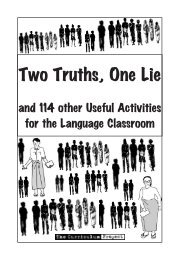
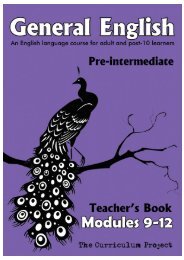

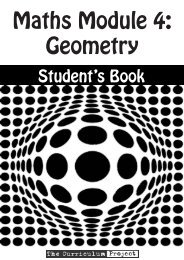

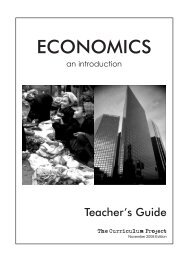
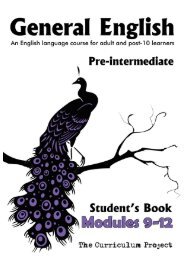

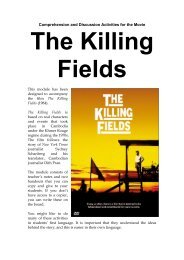
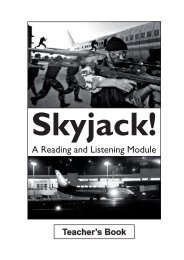
![[Eng] Nov 2012 DRAFT - The Curriculum Project](https://img.yumpu.com/45590859/1/184x260/eng-nov-2012-draft-the-curriculum-project.jpg?quality=85)

